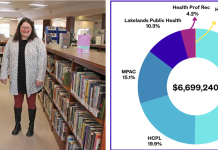Dysart et al mayor Murray Fearrey is taking aim at Haliburton County’s gasoline re-sellers, questioning why prices remain so high at Highlands pumps compared to other nearby areas.
Expressing his frustrations at a Sept. 24 Dysart council meeting, Fearrey said the rapid increase in fuel costs in recent years is making life difficult for County residents, a tough pill for the mayor to swallow given most locals need a car to get to and from work and to live their lives.
“It’s not really a municipal issue, it’s not in our mandate to focus on or be worried about, but I am worried. This affects our citizens in a huge way,” Fearrey said.
On his recent travels, Fearrey noted the price point for gasoline to be much cheaper in communities such as Lindsay, Peterborough, and Orillia than the County. Early last week, gas could be bought at the Haliburton Mobil for $1.56 per litre – it was a couple cents cheaper at gas bars in Minden, but as much as 20 cents cheaper at pumps in Kawartha Lakes.
Fearrey has reached out to owners of local stations to find out why the disparity is so significant. He said he’s yet to hear a reasonable explanation.
“When you start talking about a price difference of 60 or 70 cents per gallon, that’s an awful lot. I want to see if there’s a way to improve on that. See what the rationale is for hiking up the price here,” Fearrey said.
Costs more to haul gas to rural areas
Expert answers
Prices have fallen over the past seven days, with gas available in Haliburton for $1.48 per litre on Oct. 1, $1.46 in Minden, and $1.50 in Wilberforce. To Patrick De Haan, head of petroleum analysis with the website GasBuddy, that’s a typical fluctuation in today’s market.
“Because we have a global market, the price of oil is constantly changing at a moment’s notice,” De Haan said.
He said the industry took a massive hit during the pandemic, with global demand slowing to a snail’s pace through much of 2020 and early 2021. This brought prices way down, to less than 80 cents per litre across much of Ontario.
Petroleum producers lost billions in a matter of months, De Haan said.
“When the price was so low, producers threw in the towel. They stopped producing until the market improved,” he noted.
That turn came in 2022, with prices eclipsing the $2 per litre mark in most areas by that summer. The quick rise was blamed on Russia’s invasion of Ukraine, with De Haan saying the market is quick to react to major world events.
“We went from one side of the extreme where there was no demand at all for gas, which drove prices down and caused supply to drop. When the economy reopened, demand increased very quickly and was exacerbated by one of the world’s largest oil producers invading another country – the risk of disruption of action to oil markets was increased… so prices went up,” De Haan said.
Cost breakdown
The Canadian Fuels Association (CFA) said there are four key components to pricing gas in Canada – the cost of crude oil, wholesale prices, retail mark-up, and taxes.
A 2023 CFA report found the average price at pumps in Toronto that year was $1.54 – of that, 64 cents went to crude costs (42 per cent), 50.3 cents to taxes (31 per cent), 31.6 cents to refiners’ operating margins (21 per cent), and 8.9 cents (six per cent) to the selling business.
De Haan said most retail stations have profit margins between five and 15 cents per litre. He feels the County’s rates are fair.
“Ultimately, it sounds like there might be a real aggressive competitor down the road [in Lindsay and Orillia] that is keeping prices down. Some stations are willing to take less of a profit margin if it’s new… the reality too is it costs more hauling gasoline to rural areas, so that might be why you’re seeing a bigger difference,” De Haan said.
Dysart Ward 4 coun. Carm Sawyer, who runs West Guilford Auto Centre, said when he was in the gasoline business several years ago, he was charged 10 cents per litre more for wholesale fuel than stations in Minden were charging customers.
The Highlander reached out to several stations to explain their methods for pricing gas but could not secure an interview. Thea Bourne, spokesperson for BG Fuels, which owns Haliburton Mobil, said in an email, “it is BG Fuels’ standard policy to not comment publicly regarding the management of its retail fuel prices.”
Local reaction
Alan Cook was filling his truck in Minden Sept. 27.
“It’s a bargain compared to what it was about two months ago, but it’s still outrageous. We seem to get robbed quite nicely up here – I have a cottage in Penetanguishene and gas is always cheaper in Orillia,” Cook said, estimating price increases since 2020 have added an extra $100 to his commute from Minden.
Ashley Willoughby said she and her husband work outside the County and are now paying hundreds of dollars a month more for fuel than they were before the pandemic. The Minden resident said she often feels trapped at home as there isn’t much money left over for big outings.
Living on a fixed income, retired Haliburton resident Scott Spong said he’s been forced into adjusting his driving habits.
“Everything is planned out now. No more driving back and forth to get a loaf of bread – instead of 10 little trips I have to make sure I know what I need and where I’m going, because it’ll be a few days before I’m in town again,” Spong said.
De Haan warned residents current rates are likely here to stay.
“I think this may be the new norm – Canada’s carbon tax is going up every year… there’s going to be a continued rise regardless of how low the price of oil goes,” he said, with a barrel of crude running approximately $94 as of Oct. 2.
“I hear a lot of people saying things like ‘the price of oil is a lot lower than in 2008, so why am I paying a whole lot more?’ That’s because taxes have gone up, the cost of doing business has gone up. There’s been a lot of core inflation on the price of gasoline,” De Haan added.





